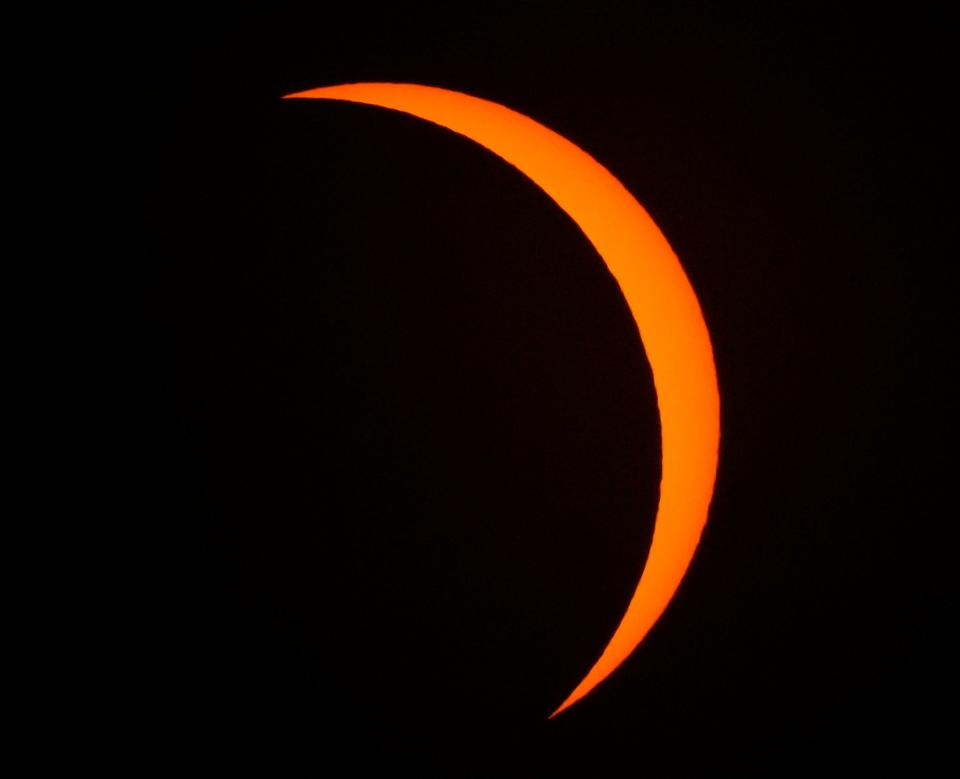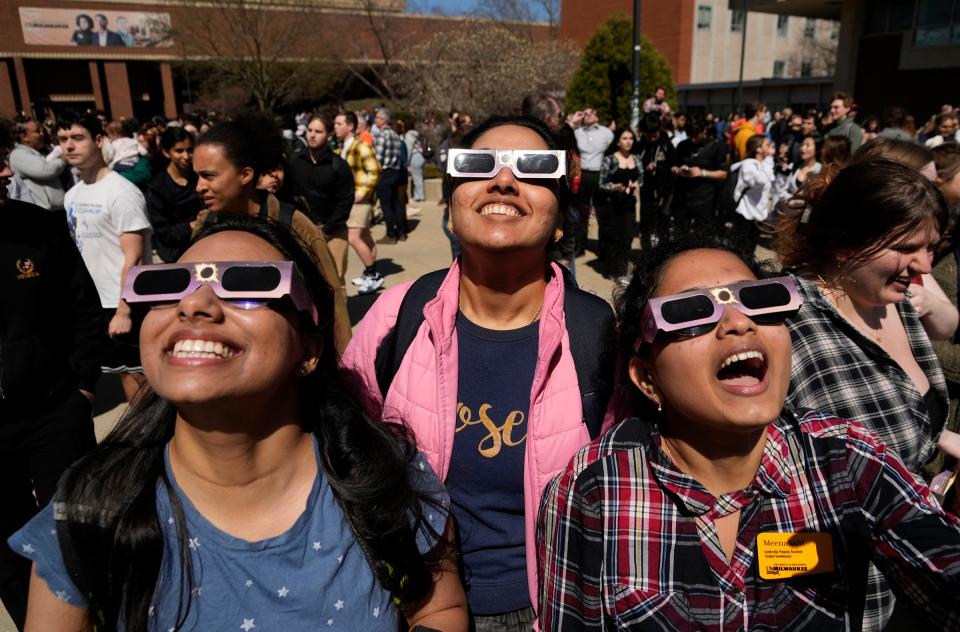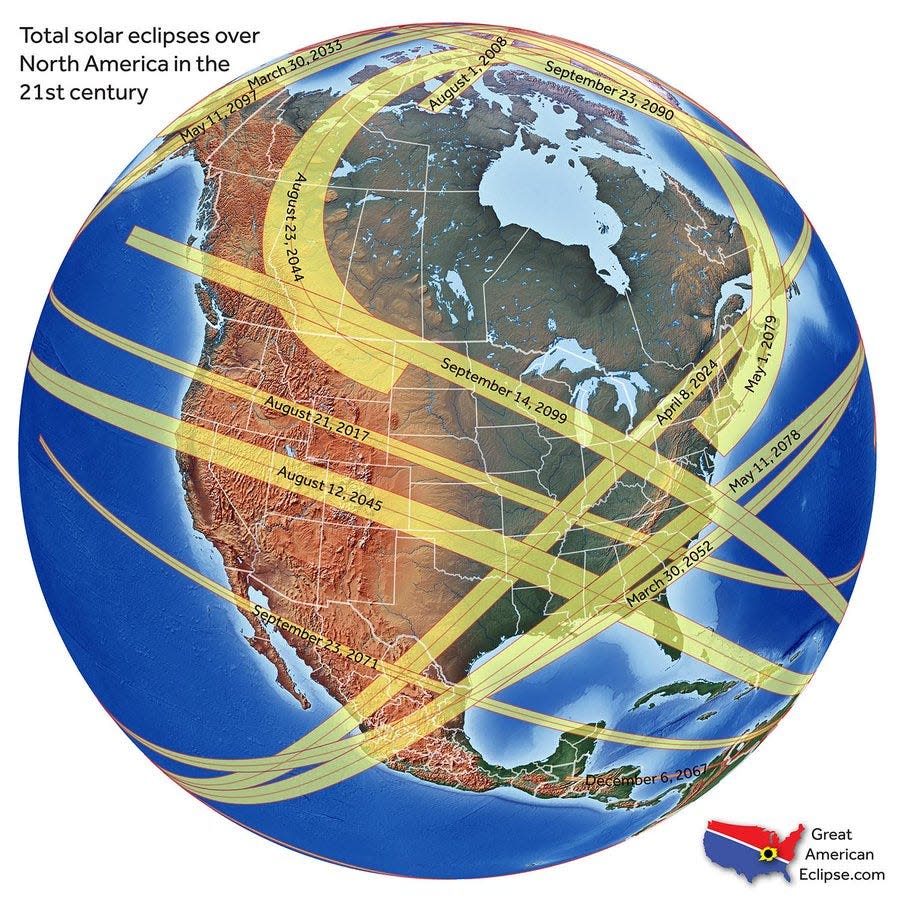Replay: 2024 solar eclipse in Milwaukee, Wisconsin, highlights from historic celestial event
A total solar eclipse darkened the skies Monday across the continent.
Milwaukee was not on the path of totality, but experienced about 90% coverage. The eclipse was expected to peak about 2:08:10 p.m. in Milwaukee. It began at 12:53:00 p.m., and it reached 50% of the maximum coverage at 1:33:50 p.m. After peaking at 2:08:10 p.m., 50% of the maximum coverage was again visible at 2:42:20 p.m. The eclipse ended in Milwaukee at 3:21:50 p.m.
If you lived in the southeastern parts of the state — including Milwaukee, Racine, Kenosha, Lake Geneva and Janesville — you had the best chance out of anywhere in Wisconsin at seeing the partial solar eclipse. Much of the state was expected to have cloud cover that could obscure it.
2 p.m. - Students and community members watch the eclipse's peak from UWM bridge
Students, faculty and members of the community gathered on the bridge leading into the University of Wisconsin-Milwaukee Student Union to watch the eclipse's peak at 2:08 p.m.
Some said the overcast skies at the eclipse's peak made the world look like an "Instagram filter." Other students admitted to skipping all or part of class to watch the event.

"It's pretty cool to see it. I've never seen an eclipse before, at least not to this totality," said Reyna Delikat, a junior at UWM who gathered at the bridge with three friends.
Delikat said she and her friends waited in a long line to receive free eclipse glasses at the union. Other students said the glasses ran out by the time they got to the union and were sharing them amongst each other to catch glimpses of the sun.
— Claire Reid
12:50 p.m. - Eclipse-watchers gather outside Milwaukee Public Museum
A crowd of about 100 people, including children and adults of all ages, gathered outside the Milwaukee Public Museum to watch the partial eclipse. Museum educators helped attendees use telescopes as the eclipse approached its peak. Inside the museum, visitors could explore models of the sun and planets.
Planetarium educator Marshall Ward projected the eclipse onto a piece of poster board so those without eclipse glasses or a telescope could see the moon's shadow covering the sun. Despite earlier worries of cloudy weather making it difficult to view the eclipse, the sky was completely clear.
"It's just a gorgeous day out," said Dane of Milwaukee, who attended the museum event with their boyfriend, Davis. "I was worried yesterday that the rain was going to block everything."
"But we got lucky," Davis added.
Ken Knobel of San Francisco traveled to Wisconsin to visit his son at UW-Madison over the weekend and decided to watch the eclipse from Milwaukee because of the clear skies.
"I think the most exciting part of it is that it's, for some people, once in a lifetime," said Knobel, who said it's the first eclipse he's ever watched.
- Claire Reid
12:26 p.m. - How long will the eclipse last in Wisconsin?
For much of Wisconsin, the solar eclipse will start just after 12:50 p.m. and end after 3:20 p.m. The peak, though, is the time that is most important. That will take place between 2:05 and 2:10 p.m.
In Milwaukee, the partial solar eclipse will take place for 2 hours 29 minutes, beginning at 12:52 p.m. and ending at 3:21 p.m.
At its peak, 89.6% of the sun will be obscured by the moon in Milwaukee. That will happen at 2:08 p.m.
You can find more specific eclipse times for other Wisconsin cities here.
— Christopher Kuhagen
11 a.m. - Where, how to watch a solar eclipse livestream
You can find a livestream of the eclipse here:
Various local viewing events will also be broadcasting NASA's livestream of the eclipse. If you can't get out to an event, here's a link to NASA's stream.
— Steve Martinez
10:45 a.m. - How do I know my eclipse glasses are legitimate?
Making sure your eclipse glasses are legitimate is important because staring directly at the sun, even for a short time, can cause permanent damage to your retinas, a light-sensitive part of the eye that transmits what you see to your brain.
Here's what to look for to make sure your glasses are legit:
Your eclipse glasses should be marked with the ISO certification number ISO 12312-2 on the glasses' frame and registered as a 'Solar Viewer Brand' with the American Astronomical Society (AAS).
Objects should be hardly visible when you're wearing legitimate glasses indoors, the AAS says, and outdoors, objects except the sun's reflection on shiny surfaces should still be hard to see.
Check the filters on the glasses for scratches and tears. The frame shouldn't be loose in any way. If there are any damages, replace them with a new, certified pair.
10:33 a.m. - Should I be worried about my pets' eyes during the solar eclipse?
You don't need to worry about your pets during an eclipse since they don't normally look up at the sky and have an aversion to bright light, experts say.
If you are bringing your pet to a local eclipse viewing event, you don't need to get them eclipse glasses because there's no fear of animals hurting themselves by looking at the blocked sun. Any type of eye covering is more likely to bother them than anything, according to experts.
Moreover, you should not force your pet to look at the eclipse.
10:10 a.m. - How to take a photo of the eclipse with your phone
You can capture Monday's solar eclipse in Wisconsin with your cellphone, according to NASA.
You'll need to use a solar filter to protect your camera, and you'll also need a pair of solar viewing glasses to protect your eyes.
For more information on how to best capture the eclipse, you can visit NASA's website.
— Alex Groth
9:30 a.m. - Where to find eclipse glasses in and around Milwaukee, free solar eclipse glasses
Eclipse glasses are available for free, while supplies last, at Warby Parker. There are two Warby Parker locations in Wisconsin, in Milwaukee's Third Ward and blocks from the state capitol building in Madison.
Glasses will also be given out at some local events. You can find a list of viewing events here. Glasses will also be sold in some stores, such as American Science and Surplus, 6921 W. Oklahoma Ave., Milwaukee. Eclipse glasses are available for purchase while supplies last.
If you can't get your hands on some glasses, you can try your hand at crafting a DIY pair. Eclipse viewers can be made out of common household items such as cereal boxes, colanders, and cardboard or paper tubes. Tutorials on how to make your own glasses are available here.
— Steve Martinez
8:45 a.m. - Eclipse forecast shows clear skies in Milwaukee, clouds likely in western Wisconsin
Despite some worries last week that cloud cover might make the partial eclipse difficult, if not impossible, to see from Milwaukee, the National Weather Service said Monday morning that the forecast looks promising for viewing the astronomical event from our area.
"As we've gotten closer to today ... the skies have become more clear," said local NWS meteorologist Mark Gehring.
The Milwaukee area is expected to see clear skies this morning and potentially a few light clouds in the afternoon. The day is expected to be sunny, with a high of 63 degrees.
Other areas of the state might not have as much luck viewing the eclipse. A low-pressure system currently casting clouds over Iowa could make eclipse-viewing difficult from west-central Wisconsin, Gehring said. Clouds are also in the forecast for northern Wisconsin and much of Minnesota.
Mostly clear skies this morning will give way to some thinner higher clouds this afternoon especially northwest, while less clouds expected for southeast WI. Be safe and protect your eyes during the eclipse! #wiwx pic.twitter.com/Xta1Xd379c
— NWS Milwaukee (@NWSMilwaukee) April 8, 2024
La Crosse is currently experiencing partly cloudy conditions, Gehring said. It's possible these don't clear in time for eclipse-viewing from the La Crosse and Eau Claire areas, but the "heating of the day" could sufficiently break up the clouds.
— Claire Reid

What time is the solar eclipse in Madison, Janesville and other southern Wisconsin cities?
As the eclipse travels along its southwest-to-northeast path across the country, cities in western Wisconsin will see it slightly before the Milwaukee area. However, cities in southeastern Wisconsin are closer to the path of totality than those in the west and will perhaps see more noticeable overcast skies during the partial eclipse's peak.
Here's when the eclipse will peak in some of southern Wisconsin's major cities:
Platteville: The partial solar eclipse will reach its peak at 2:04:30 p.m. in Platteville when the moon covers 86% of the sun. The city will experience the eclipse from 12:49:20 p.m. to 3:18:30 p.m. Residents can see the eclipse at 50% of its peak coverage at 1:29:20 p.m. and again at 2:39:30 p.m.
Richland Center: The eclipse will reach its peak at 2:05:10 p.m., and the moon will cover 84% of the sun. Richland Center will experience the partial solar eclipse from 12:50:30 p.m. to 3:18:40 p.m. The eclipse will be at 50% of its peak coverage at 1:29:50 p.m. and again at 2:40:10 p.m.
Madison: The eclipse will reach its peak at 2:06:10 p.m. when the moon covers 86% of the sun. The city will see the partial eclipse from 12:51:10 p.m. to 3:19:50 p.m. Madisonians can see the eclipse at 50% of its maximum coverage at 1:31:10 p.m. and 2:40:50 p.m.
Janesville: The eclipse will peak at 2:06:30 p.m., and the moon will cover 88% of the sun. Janesville will experience the eclipse from 12:51:10 p.m. to 3:20:20 p.m. The eclipse will be at 50% of its peak coverage at 1:31:50 p.m. and again at 2:40:50 p.m.
Waukesha: The eclipse will reach its peak at 2:07:40 p.m. when the moon covers 89% of the sun. Waukesha will see the partial solar eclipse from 12:52:30 p.m. to 3:21:20 p.m. Skywatchers can view the eclipse at 50% of its maximum coverage at 1:33:10 p.m. and again at 2:42:00 p.m.
Kenosha: The eclipse will reach its peak at 2:08:00 p.m., and the moon will cover 91% of the sun. Kenosha will experience the eclipse from 12:52:30 p.m. to 3:21:50 p.m. Residents can see the eclipse at 50% of its maximum coverage at 1:33:40 p.m. and 2:41:50 p.m.
— Claire Reid
What time is the solar eclipse in Wisconsin?
For those living outside Milwaukee, you can enter your ZIP code, or select your city, below to see when the solar eclipse will reach your area and for how long, as well as what percent of the sun will be obscured at the eclipse's peak.
Can't see our graphics? What time is the total solar eclipse on April 8? Search your ZIP code for a viewing guide
What will the weather be like in Wisconsin, Milwaukee for the total solar eclipse?
Much of the state is expected to have cloud cover that could obscure the eclipse, though when those clouds will move out and open up a view is still up in the air. The timing could become more certain by late Monday morning.
"It is going to be dicey as far as cloud cover goes," explained John Gagan from the National Weather Service in Milwaukee. "Milwaukee will kind of be in an area where they could see some clearing, but I don't know if we're going to see 100% clear skies."
Going north and west from Milwaukee, it's more likely that clouds will prevent seeing the eclipse. For example, Madison is right on the line. It's "entirely possible" that the skies could clear up in time, especially because the eclipse peaks around 2 p.m. there.
The same is true for northeastern Wisconsin. Appleton and Green Bay will start the day with "quite a bit of cloud cover," but skies will partially clear by the late morning or early afternoon, explained Scott Berschback from the National Weather Service in Green Bay.
— Hope Karnopp
Here are some Milwaukee area solar eclipse events
Even if the weather puts a damper on your eclipse plans, you can still mark the rare astronomical occasion with these indoor or virtual events in the Milwaukee area:
UW-Milwaukee: UWM will offer indoor activities, including a livestream of the total solar eclipse, free pizza, a photo booth and photo station, and a variety of astronomy-themed crafts, in the Union Ballroom from 1 to 3 p.m. on Monday. An outdoor eclipse watch and activities will take place, too, weather permitting. More: Solar Eclipse Viewing Party | Manfred Olson Planetarium.
Milwaukee Public Museum: MPM will stream NASA's live webcast of the total solar eclipse and has indoor educational activities planned in the event of inclement weather. Outdoor viewing and activities are also planned. Monday, 12:30 to 3 p.m. More: 2024 Solar Eclipse Watch | Milwaukee Public Museum.
Brookfield Public Library: The library will host a free, indoor stream of NASA's live webcast in the library's community room. Monday, 12:30 to 3:30 p.m. More: Brookfield Public Library ? Solar Eclipse Streaming.
— Claire Reid, Jordyn Noennig
More local eclipse events: Can't travel for the April 8 solar eclipse? Experience it at these Milwaukee eclipse events

When is the next total solar eclipse in Wisconsin after 2024?
After Monday, the lower 48 states won't see another total solar eclipse until Aug. 23, 2044. However, only three states ― Montana, North Dakota and South Dakota ― will be on its path of totality. According to NationalEclipse.com, most Western and Midwestern states, including Wisconsin, will see a partial eclipse during this event.
Thankfully, you won't have to wait another 20 years for the next total solar eclipse, though. Less than a year later on Aug. 12, 2045, another one will grace the skies. Its path of totality will touch South America, the Caribbean and 15 U.S. states from California to Georgia. Wisconsin and most of the Midwest will again see a partial eclipse.
The next time Wisconsin will be on the path of totality for a total solar eclipse will be Sept. 14, 2099, said Dr. Jean Creighton, director of the University of Wisconsin-Milwaukee's Manfred Olson Planetarium. Milwaukee and much of the rest of the Midwest will be on the path, according to NASA.
Wisconsin was last on the path of totality 70 years ago. Northwestern portions of the state, including Spooner and St. Croix Falls, experienced totality on June 30, 1954. Meanwhile, Milwaukee hasn't seen totality since the Middle Ages, Creighton said. The city hasn't been on the path of a total solar eclipse since May 16, 1379.
— Claire Reid
This article originally appeared on Milwaukee Journal Sentinel: 2024 solar eclipse highlights, updates in Milwaukee, Wisconsin
